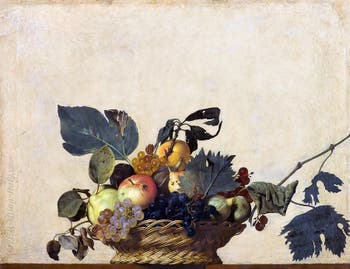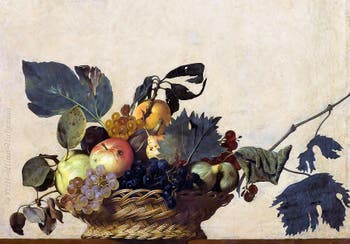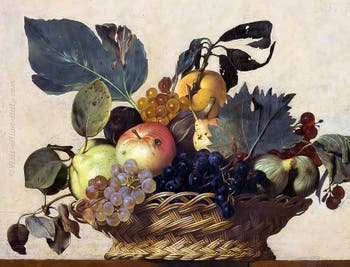Museums Ambrosiana | Castello Sforzesco | Poldi Pezzoli
Ambrosiana Artists | Location | Opening Hours Tickets | Authorizations
Artists Leonardo da Vinci | Botticelli | Raphael | Caravaggio | Titian | Luini | Bassano | Bramantino | Lucretia Borgia | Piazza | Pinturicchio | Tiepolo | Veronese B. | Vivarini
Caravaggio “Basket of Fruit” at Ambrosiana Gallery in Milan Italy
Caravaggio (September 29, 1571 - July 18, 1610) “Basket of Fruit”
Painting - Oil on Canvas (54.5 cm x 67.5 cm) 1597-1600The “Fruit Basket“ has been in the Pinacoteca Ambrosiana in Milan since it was created.

Caravaggio, Basket of Fruit This still life was created in 1595-96 on a commission from Cardinal Del Monte to offer it to the archbishop of Milan, Cardinal Federico Borromeo.
Del Monte and Borromeo shared the same interests in science and passion for painting.
Cardinal Borromeo already had a fine collection of still life paintings, particularly by the Flemish Jean Bruegel.
This great art lover was the founder of Ambrosiana, to which he bequeathed the “Fruit Basket“ by will in 1607.
Caravaggio created a masterpiece that shook up the hierarchy of painting genres inherited from the Renaissance, where man was at the top.
Still life was just a hobby, artistic entertainment.

Caravaggio, Basket of Fruit The “Fruit Basket“ is the revealing masterpiece of Caravaggio's genius, who inaugurated the modern phase of painting by showing that the beauty of a painting does not depend on its subject but on its pictorial quality.
Like a portrait, the “Fruit Basket” stands out against a perfectly uniform light background that highlights the colours of the fruits and gives relief to the details of the realistically painted wicker braiding.
Here, we can see the wicker basket placed in the arms of the very handsome “Young man with a fruit basket” painted one or two years earlier by the artist.
The fruits and leaves overflow abundantly from the basket, which crushes slightly under their weight on the right, without being able to tell if it is round or oval.
The fruit basket is placed on a table (or a shelf) and presented in profile by a simple brown line extending across the width of the base of the table, just at the level of the viewer's eyes who notices that it extends beyond the edge of the table, to offer itself to him and invite him to approach her!

Caravaggio, Basket of Fruit And here, the beautiful round apple is pierced by a worm that gnaws it from the inside, the beautiful clusters of juicy grapes have grains that are beginning to rot, and the spotted pear will soon be white.
Parasites attack some leaves or are half-withered, while the quince next to the apple is barely ripe, and the figs next to the black grape are still green.
Instead of selecting exceptional fruits as Flemish still life painters did, Caravaggio painted ordinary fruits sold in markets.
The realism of their faults and particularities contrasts with the flatness of a neutral background that allows the eye to perceive the outline of leaves and fruits precisely.
As in Chinese paintings, a plain background without any reference mark allows space to be perceived in the image.
Caravaggio combines almost photographic precision with an attenuation of the relief, which is hardly suggested by the shadows of the fruits illuminated by a razor light from the left.

Caravaggio, Basket of Fruit This lighting, almost parallel to the canvas's surface, defines the fruits' contours and volumes thanks to their cast shade and the reflections on their skin.
It reveals the freshness of water droplets, the fineness of their skin texture, and the leaves' veins.
The softness of the light highlights the colour nuances of the leaves and fruits.
Their delicate colours, without brilliance, highlight their ephemeral freshness.
The worm gnaws at the fruit, and the leaves are damaged, sap-deprived and shrunken; grape seeds rot next to immature fruits, and a vine shoot tilts towards them to the right.
The realism and finesse of these details show the fragile beauty of life and the influence of time in its cruel truth.
Caravaggio's Fruit Basket is as expressive as a rich “vanity” where the symbols of the passage of time and death are among all sorts of entertainment objects and consumer goods that are the pleasures and delights of life.

Caravaggio, Basket of Fruit Caravaggio had chosen to paint everyday fruits whose moral dimension was known to everyone since ancient times.
They are featured in Greco-Roman mythology and the Bible.
The quince was the symbol of love and fertility attributed to Venus; it is the golden apple of the Hesperides garden.
The ancient Romans considered it to be a remedy for poisoning.
The quince symbolises redemption in the hands of the baby Jesus in a Bellini painting.
The apple evokes original sin and represents the forbidden fruit of the tree of knowledge consumed by Adam and Eve.
The peach, composed of pulp and a kernel housing its almond, represented the Christian trinity.
The fig nourishes and heals: “Bring a fig cake, rub the ulcer and let him (King Ezechik) heal.” Isaiah 38, v 21 and 22.
The fig tree is a Judeo-Christian symbol: it is the tree of the origins of Rome, the tree whose leaves served to cover the nakedness of the original couple.
According to the legend of the founding of Rome, the basket where Remus and Romulus were carried away on the Tiber's waters and they had miraculously stopped under a fig tree.

Caravaggio, Basket of Fruit The Bible (Genesis III, 7) tells us that Adam and Eve hid their nakedness by making girdles out of fig leaves.
And Judah, the one who betrayed Jesus for money, was overcome with remorse and hanged himself on a fig tree.
The pear, whose shape evokes the female body, is appreciated for its softness and delicacy.
Since Homeric times, the pear was an attribute of Venus and Juno (the queen of Olympus).
A symbol of maternal sweetness, it was featured in some paintings of Madonna and Child.
Grapes are the Eucharistic symbol of excellence: they represent the blood of Christ shed to redeem the sins of humanity.

Caravaggio, Basket of Fruit The withered vine branch represents the sinner who has broken the Covenant and who ignores the word of the Lord; it will be destroyed:
“Dried vine wood is only for burning.”
Ezekiel 15, v 2 to 5.
The same infidel who ignores the word of Christ in the Gospel:
“I am the vine; you are the branches.
He who abides in me and in whom I abide bears much fruit because you can do nothing without me.”
“If anyone does not remain in me, he is thrown out, like the branch, and it dries up; then the branches are picked up, thrown into the fire, and they burn.”
John 15, v 5 and 6.
Caravaggio's “Fruit Basket” thus appears as an allegory of the Church placed under the light of the Lord, illustrated by a uniform yellow background like an icon.
Cardinal Federico Borromeo had fully grasped the aesthetic and spiritual value of the “Fruit Basket”.
He considered it as beautiful as his paintings by Bruegel and did not see any painting from his collection that could be placed alongside it: this exceptional work deserved to be alone.
This is still the case today when it will appear before your eyes, solitary, as its donor intended.
Artists Leonardo da Vinci | Botticelli | Raphael | Caravaggio | Titian | Luini | Bassano | Bramantino | Lucretia Borgia | Piazza | Pinturicchio | Tiepolo | Veronese B. | Vivarini
Ambrosiana Artists | Location | Opening Hours Tickets | Authorizations
Museums Ambrosiana | Castello Sforzesco | Poldi Pezzoli
Back to Top of Page

